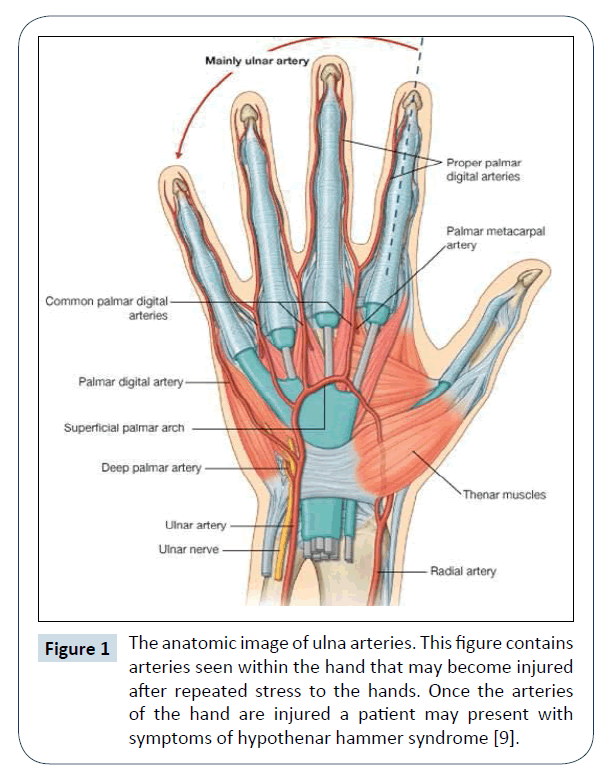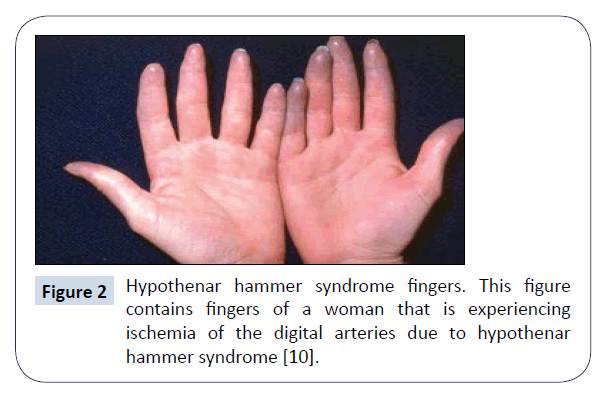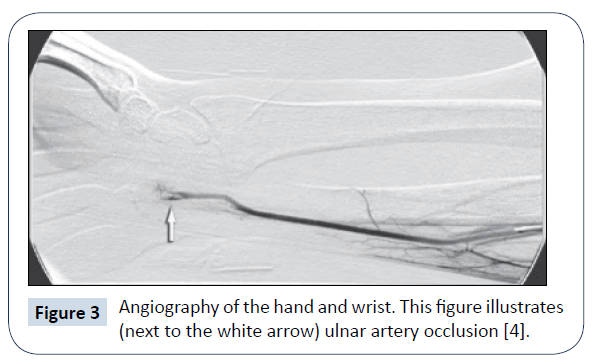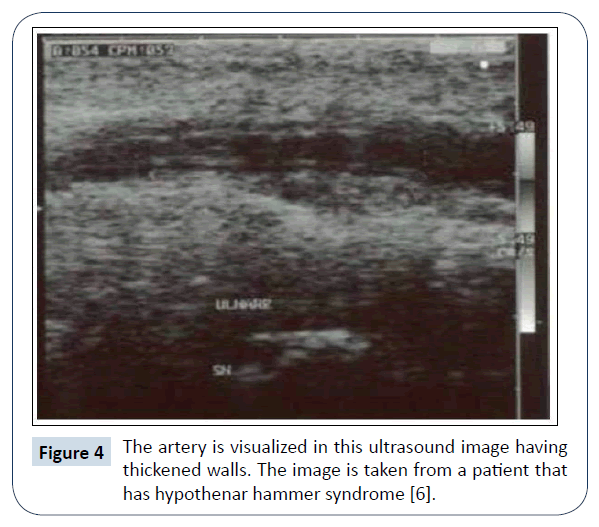Delores Jones*
Registered Diagnostic Medical Sonographer, American Registry of Diagnostic Medical Sonography, USA
*Corresponding Author:
Delores Jones
Registered Diagnostic Medical Sonographer from American Registry of Diagnostic Medical Sonography
Masters in Health Administration from University of Phoenix, USA
Tel: 301-7388401
E-mail: delolo1979@yahoo.com
Received Date: March 31, 2017; Accepted Date: April 19, 2017; Published Date: April 26, 2017
Citation: Jones D. Hypothenar Hammer Syndrome. J Healthc Commun. 2017, 2:3. doi: 10.4172/2472-1654.100061
Keywords
Hypothenar hammer syndrome; Medical technology; Radiology modalities; Ischemia; Hand trauma
Introduction
Hypothenar hammer syndrome is an infrequent disorder of the arteries found within the hand. The arteries found within the finger have blood clots that cause blockages in the digital arteries. This condition is often caused due to repetitive injury to the palmer ulna. That is why this condition is called hammer syndrome from the repeated blows to the hand [1,2]. The repeated strikes of the hands result in the injury to the main arteries of the hand and arms (the radial and ulnar arteries). Hypothenar hammer syndrome results in hand ischemia and loss of oxygenated blood and nutrients. This condition is often misdiagnosed, however, due to the improvement of health technologies, many health care facilities are now able to detect this medical condition. Thus, it is important to obtain a thorough patient history. Many patients that have this syndrome are work within professions that have repeated exposure to hand trauma. Some professions that result in this syndrome are golfers, farmers, tennis players, mountain bikers, hockey players, weight lifters, and construction workers [3]. This article will discuss the symptoms and technologies utilized to detect hypothenar hammer syndrome.
Discussion
Hypothenar hammer syndrome is not the most common disorder of the artery and veins but occurs in many people throughout the world. People that have jobs that require strenuous activities, those that play sports, and people who smoke are more susceptible to this medical conditions than others. Many doctor’s offices and health facilities have patients that experience hand, finger, or wrist pain. Patient’s that may have this condition may enter with those symptoms as well as other specific clinical findings that point to this specific medical condition [4,5].
Hypothenar Hammer Syndrome Defined
Hypothenar hammer syndrome is a health condition resulting from a deficiency of the blood flow within the hand. Hypothenar hammer syndrome is caused by trauma to the hand or caused by reoccurring compression, squeezing, or hammering of the hand. The injury to the blood vessels of the hand causes pain and aching of the hand. Those that have hypothenar hammer syndrome presents with clinical findings such as cyanotic (blue) fingers, paresthesia, paralysis, cold intolerance to their hands, extreme sensitivity in fingers, and possible ulcers at the tips of the fingers [6]. All of these symptoms may occur more frequently in men that are around the age of 40. These symptoms can be the result of injuries that are obtainable from occupational jobs that require individuals to use tools that require them to squeeze or hit objects repetitively (such as with a hammer). Some occupations that require more use of the hands would be miners, bakers, carpenters, or automotive repair employees. Individuals that play sports such as karate, tennis, baseball, or sports that require repetitive hitting or squeezing are also more susceptible of obtaining hypothenar hammer syndrome [4]. Figure 1 presents the anatomic appearance of arteries found within the hands that may become injured as a result of sports or occupation that may cause this syndrome. Additionally, trauma (such as injury directly to hand) can result in this medical condition. Figure 2 presents the appearance of a person who has ischemia or loss of oxygen to parts of the hands or fingers due to blockages (or clots) within the arteries. The lack of blood flow is represented as a darkened or bluish discoloration of the digits in Figure 2.

Figure 1: The anatomic image of ulna arteries. This figure contains arteries seen within the hand that may become injured after repeated stress to the hands. Once the arteries of the hand are injured a patient may present with symptoms of hypothenar hammer syndrome [9].

Figure 2: Hypothenar hammer syndrome fingers. This figure contains fingers of a woman that is experiencing ischemia of the digital arteries due to hypothenar hammer syndrome [10].
Diagnosis
There are several radiologic modalities that are now able to detect this rare health condition. Hypothenar hammer syndrome can be diagnosed with medical technologies such as angiography, computed tomography, magnetic resonance imaging, and ultrasound. Angiography is the number one (gold star) of radiologic modalities to detect this medical condition [4]. Angiography allows for a map of all internal vessels to be seen on the hand, wrist, and arm. Angiography illustrates if any arterial blockages (or clots) are seen on the hand. Figure 3 shows an image obtained from angiography of an ulnar artery occlusion (total blockage of an artery) resulting in hypothenar hammer syndrome. The ulnar artery is pointed to by the white arrow within the image.

Figure 3: Angiography of the hand and wrist. This figure illustrates (next to the white arrow) ulnar artery occlusion [4].
CT (computed tomography), ultrasound, and MRI (Magnetic Resonance Imaging) can also be used to diagnose Hypothenar hammer syndrome. All of these modalities are very sensitive to detecting arterial damage within the hand. Though these radiologic areas are not the gold standard for detecting hypothenar hammer syndrome, they provide alternative methods for assistance in diagnosing a patient so that they may get treated. If a medical facility doesn't have angiography available, one of these alternative modalities can be used to determine if a patient has hypothenar hammer syndrome correctly. Ultrasound modality is often selected to perform a noninvasive test on a patient because it is low cost and can quickly determine if there are clots within the arteries of the hand, wrist, and arm [7]. Figure 4 illustrates the artery in a patient that has hypothenar hammer syndrome. The artery is seen in the ultrasound as having thickened walls which indicate there is a clot in the artery.

Figure 4: The artery is visualized in this ultrasound image having thickened walls. The image is taken from a patient that has hypothenar hammer syndrome [6].
Medical Treatment
Hypothenar hammer syndrome can be treated by surgery or a medicine regiment. The selection of the type of treatment is usually dependent upon how severe the patient’s symptoms are. If a patient has ischemia and not adequate blood circulation, then surgery is more favorable for the patient’s medical treatment. Surgery would be performed to unblock arteries or to reconstruct arteries. However, if a patient has symptoms that are manageable, the treatment would be no surgical. Patients would be advised to changing jobs (so that any further damage to the hand would be prevented). Other nonsurgical medical treatments would include wearing gloves to avoid extremely cold temperatures, wearing thick gloves for a cushion to the hands, and medication (such as medicine that would help prevent further clots within the arteries of the hand). Additionally, if the patient smokes, it is suggested that they stop smoking to prevent further damage to the hands and wrists [8].
Conclusion
Hypothenar hammer syndrome is an infrequent medical condition that can be hard to diagnose and derives from trauma or repeated stress to the upper extremity (hand or wrists). This syndrome is caused by damaged arteries within the hand or wrists that result in pain, ischemia, and several related clinical symptoms. However, if physicians and health professionals utilize various technologies such as CT, MRI, Angiography, and ultrasound patients can be quickly diagnosed so that they can be treated for their medical condition. Individuals that have hypothenar hammer syndrome presents with symptoms that are closely related to another medical condition called Raynaud’s disease [7]. Medical professionals must thoroughly evaluate patients so that hypothenar hammer syndrome is not misdiagnosed with Raynaud’s disease.
References
- Matthews R, Relan N (2008) Advances in healthcare technology: shaping the future of medical care. J Nucl Med 49: 336.
- Lorelli DR, Shephard AD (2002) Hypothenar hammer syndrome: an uncommon and correctable cause of digital ischemia. J Cardiovasc Surg (Torino) 43: 83-85.
- Cooke RA (2003) Hypothenar hammer syndrome: a discrete syndrome to be distinguished from hand-arm vibration syndrome. Occup Med (Lond) 53: 320-324.
- Ablett TC, Hackett LA (2008) Hypothenar hammer syndrome: case reports and brief review. Clin Med Res 6: 3-8.
- Swanson KE, Bartholomew JR, Paulson R (2012) Hypothenar hammer syndrome: a case and brief review. Vasc Med 17: 108-115.
- Cigna E, De Santo L, Monacelli G, Scuderi N, Spagnoli AM, et al. (2010) Case report therapeutic management of hypothenar hammer syndrome causing ulnar nerve entrapment. Plastic Surg Int pp: 1-5.
- Taj S, Malamis AP, Lomasney LM, Bednar MS (2010) Radiologic case study. Orthopedics (Online) 33: 286.
- Rabczynksi M, Kuznik E, Guzinski M, Adamiec R (2015) Critical ischemia of the fingers in an auto mechanic as a result of occupational exposure. Int J Occup Med Environ Health 28: 169-173.
- https://classconnection.s3.amazonaws.com/677/flashcards/1672677/jpg/blood_supply_of_the_hand_(2)1342943683200.jpg
- https://www.cedars-sinai.edu/Patients/Health-Conditions/Images/354016_Raynaudsphenomenon.jpg





